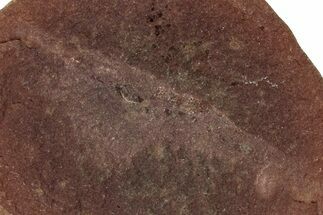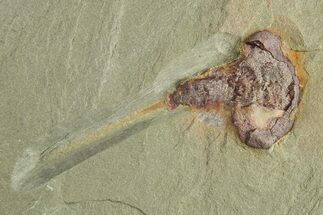This Specimen has been sold.
3.6" Scale Tree (Lepidodendron) Fossil Pos/Neg - Mazon Creek
This is a nicely defined scale tree (Lepidodendron sp.) fossil preserved inside an ironstone nodule that has been split open. It comes from the famous Mazon Creek Lagerstätte. These ironstone nodules have been collected for decades from the spoil heaps of abandoned coil mines near Coal City, Illinois.
Both halves of the nodule are included along with display stands.
Both halves of the nodule are included along with display stands.
Lepidodendron, also known as scale trees, were primitive vascular plants, thriving in the swampy environments of the Carboniferous Period about 350 to 300 million years ago. Their closest modern relatives are club mosses. They reached heights comparable to modern trees, sometimes as high as 50 meters, or roughly 160 feet.
However, unlike most modern trees their growth habit was dichotomous: younger plants grew as a single stem, from which leaves protruded directly from the trunk. As they aged, the growing ends would split into new branches, eventually creating a fractal pattern similar to modern dragon trees.
Lepidodendron grew needle-like leaves from scale-like bases along stems, from which the plants are named. At the ends of branches were oval-shaped cones similar in shape to modern cones of a spruce or fir. These cones bore spores, and only grew from the crown.
Lepidodendron may have also been among the first plants to form mycorrhizal relationships with fungi, as fossil evidence between Lepidodendron "roots" (identical to stem tissues) and early fungal organisms has been found.
However, unlike most modern trees their growth habit was dichotomous: younger plants grew as a single stem, from which leaves protruded directly from the trunk. As they aged, the growing ends would split into new branches, eventually creating a fractal pattern similar to modern dragon trees.
Lepidodendron grew needle-like leaves from scale-like bases along stems, from which the plants are named. At the ends of branches were oval-shaped cones similar in shape to modern cones of a spruce or fir. These cones bore spores, and only grew from the crown.
Lepidodendron may have also been among the first plants to form mycorrhizal relationships with fungi, as fossil evidence between Lepidodendron "roots" (identical to stem tissues) and early fungal organisms has been found.
The Mazon Creek fossil beds are a deposit with exceptional fossil preservation, known as a conservation lagerstätte, located in Illinois. This location of late Paleozoic (~307 million years old) biota ranks among the great fossil sites around the world. The large variety of fossils collected here vary between plants and animals, including soft-bodied and insect preservations. Fossils from this site are often quite detailed and are preserved within siderite (iron carbonate) nodules.
Over 500 animal and 200 flora species have been described from Mazon Creek. The event that caused this die-off and preservation is believed to have started with a catastrophic flood event that buried the biota of the modern day Mazon Creek area. The deposition of river-borne silt and clay, brought on by upland erosion and delta progradation, contributed to the incredible preservation of one of the most complete records of Paleozoic biota.
This site has been collected for more than 100 years, and likely will continue to be collected by both professionals and amateurs for many years to come.
Over 500 animal and 200 flora species have been described from Mazon Creek. The event that caused this die-off and preservation is believed to have started with a catastrophic flood event that buried the biota of the modern day Mazon Creek area. The deposition of river-borne silt and clay, brought on by upland erosion and delta progradation, contributed to the incredible preservation of one of the most complete records of Paleozoic biota.
This site has been collected for more than 100 years, and likely will continue to be collected by both professionals and amateurs for many years to come.
SPECIES
Lepidodendron sp.
LOCATION
Braidwood, Illinois
FORMATION
Francis Creek Shale, Carbondale Formation
SIZE
Fossil: 3.6" long, Nodule: 4.4" long
CATEGORY
SUB CATEGORY
ITEM
#325848
We guarantee the authenticity of all of our specimens.
 Reviews
Reviews












